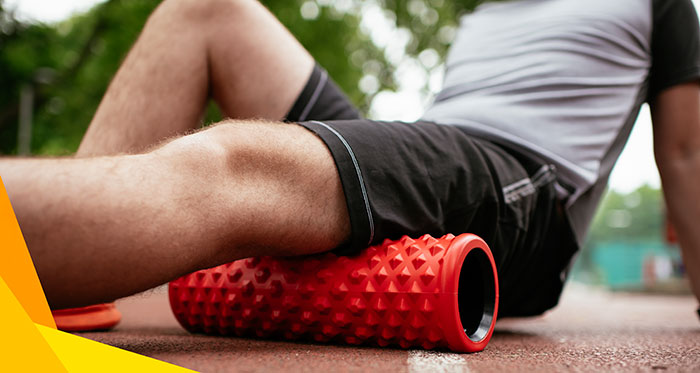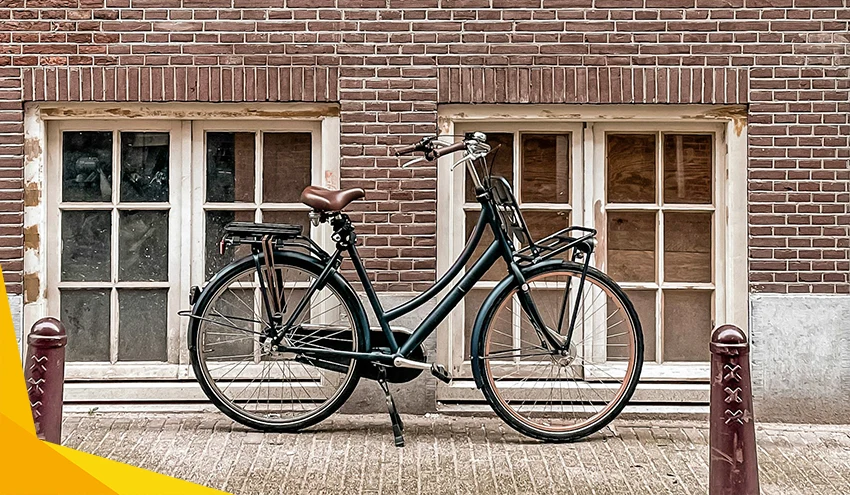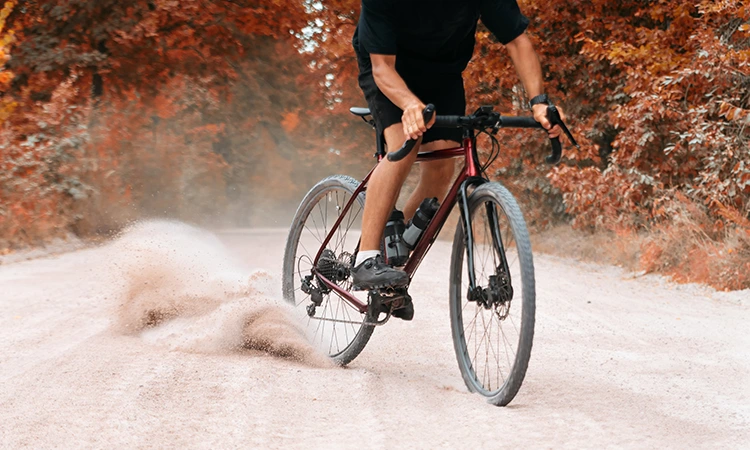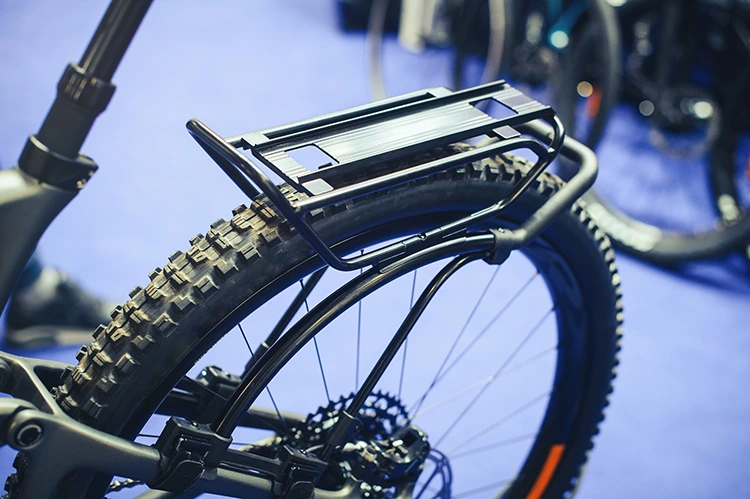There are a number of polarizing debates in cycling: disc brakes or rim brakes, socks over leg warmers or socks under leg warmers, or stretching versus not stretching? And now there is a new one: is foam rolling good for cyclists?
The scientific data supports a strong correlation between foam rolling and the claims their manufacturers make. In other words, foam rolling has been shown to relieve muscle tension and soreness, as well as increased flexibility and range of motion.
However, there are few studies – if any – which say that foam rolling will make you a faster cyclist.
What it comes down to is a personal preference. If you are naturally flexible and active every day, then a dedicated stretching or foam rolling session might not be necessary. But for the vast majority of us who sit in chairs and work at desks for the majority of the day, stretching and foam rolling could have huge benefits.
We’ll dive into stretching for cyclists briefly in this article. Our main focus will be foam rolling and the best foam rollers on the market.
Foam rollers come in all shapes and sizes, and they can be used on much more than just your legs and back.
Foam rolling used to be a niche activity for high-level athletes. It has now become a common practice for millions of people and cyclists around the world.
Scroll down to read more about foam rolling and stretching, and which movements and exercises are best for cyclists.
Best Foam Rollers
Trigger Point Performance GRID Foam Roller
- Hollow design is flexible
- Slightly contoured surface
- Portable
The Trigger Point Performance GRID Foam Roller is the best overall foam roller for cyclists. It has the best of both worlds when it comes to rigidity and flexibility.
The hollow interior combined with the rigid outer layer produces a balanced massaging feel. The unit has a maximum capacity of 500 pounds. Even the heaviest athletes can use their full body weight to help stretch out or loosen a muscle.
This foam roller’s surface is not like the others. Instead of being flat or bumpy, the Trigger Point Grid is both. The roller has rigid sections and bumpy sections that are wide enough to use one or both no matter what muscle or muscle group you’re working on.
One of the biggest downsides of the Trigger Point Grid roller (besides its price) is its overall firmness.
This foam roller is not recommended for beginners. Even with the hollow interior and padded outer layer, it is still harder and firmer than most other foam rollers.
Related: Strength Exercises For Cyclists
For experienced foam rollers and serious cyclists, this is the most balanced foam roller you can buy.
Amazon Basics High-Density Round Foam Roller
- Cheap
- Anti-slip surface
- EPP material is strong and firm
The EPP (expanded polypropylene) material used in Amazon Basic’s high-density foam roller is the same material used in most traditional foam rollers.
EPP is strong and firm but may be too much for first-time foam roller users. This edition is 18 inches long, which means it can be used for a variety of stretches and muscles from your lower back to your hamstrings and your quads. You can foam roll both legs at once with a foam roller this wide.
This foam roller may actually be a bit softer than others, which makes it a great mid-range option. It’s not going to be painful, but it won’t exactly be soft either.
At a relatively cheap price, the Amazon Basics High-Density Round Foam Roller is a great option for beginners.
Gaiam Restore Muscle Massage Therapy Foam Rollers (18 Inch)
- Softer material
- Best for beginners
- More expensive than others
The Gaiam Restore foam roller is one of our favorites because of its light and soft polyethylene foam material. This is significantly softer than the EPP material used in most other foam rollers, which can do more harm than good for the inexperienced.
However, the softer material is – unsurprisingly – not as strong as EPP. The Gaiam foam roller may deform over time.
EPP foam rollers can last for years, while the Gaiam might not last that long. But it also depends on how much you use the roller and how much you weigh. Lighter weight and less use are much less likely to deform the material.
Overall, the Gaiam is a bit expensive for foam rollers of this quality, but it fills a unique hole in the market for beginner foam rollers.
Related: How to Start Cycling (40+)
If you have super sore muscles or are worried about trying a foam roller for the first time, go with the Gaiam Restore Muscle Massage Therapy Foam Roller.
Tiger Tail Massage Stick Portable Roller (18in)
- Travel-friendly
- Able to easily adjust location and pressure
- Self-powered (good and bad)
The best part about the Tiger Tail Massage Stick is that you can put it exactly where you want it, and adjust the pressure with your very own hands. But that’s also the worst part about this foam roller: that you are the one pushing and massaging.
Depending on how tight your muscles are, self-powering a foam roller stick can be quite the workout. With most foam rollers, you can put your body weight on top of the muscle to achieve adequate pressure. But with the roller stick, you’re applying all of that pressure with your arms alone.
For light foam rolling and massaging specific muscles and knots, the stick foam roller is superior to the traditional tube foam roller. The Tiger Tail is made with non-slip handles to help you guide the roller.
There are more options than just this size. Tiger Tail offers the Massage Stick Portable Roller in 11in, 18in, and 22in sizes.
TriggerPoint Rush Foam Roller (13in)
- Expensive
- Can loosen muscles and knots that others can’t
- Diamond-shaped ridges
The Trigger Point Rush Foam Roller is the most expensive foam roller on this list, but for good reason.
Made of a rigid material patterned in a diamond grid, the Rush roller offers a hard and thorough self-massage tool that you won’t find with more basic foam rollers. The ridges can go deep into knots and small muscle groups. It can be used for the most specific trigger point work and myofascial release.
On the Rush foam roller, you can alter the intensity of each roll by placing and rolling your muscles over the unique ridge pattern.
However, this pattern won’t work well for larger muscle groups such as the quads or lower back – in fact, using it there would be quite painful.
Made for experienced foam rollers, the Trigger Point Rush is worth the cost for specific muscle work and trigger points.
Kieba Massage Lacrosse Balls for Myofascial Release (Set of 2)
- Small and portable
- Cheap
- Can be used on more than the back and legs
The Kieba Massage Lacrosse Balls are unlike the other foam rollers on this list. Instead of a long cylinder, these are small massage balls that can fit in the palm of your hand.
The tiny massage balls are travel-friendly, and even cheaper than most foam rollers on this list, even for a set of two.
What really sets these massage balls apart from traditional foam rollers is that you can target small muscles, muscle groups, and trigger points. With a long and large foam roller, you can only roll over the muscle as a whole, rather than target specific knots.
Users love using the massage balls on their neck, shoulders, lower back, and feet.
Trigger Point GRID Vibrating Foam Roller
- Travel-friendly
- Vibration therapy
- Great for more than just cyclists
The Trigger Point Vibrating Foam Roller is something you don’t see every day. Imagine if you bought a foam roller that offers a personal massage.
Trigger Point’s patented GRID surface channels your blood and oxygen through the muscle to increase circulation and accelerate recovery.
The small (3.9″) diameter provides just the right surface area and delivers targeted relief.
What makes this foam roller special, is the motor and battery. This is a cordless and rechargeable foam roller, that offers four vibration frequencies. The battery lasts up to 2 hours (depending on vibration levels used).
A small downside is, that the roller makes around 4 hours to fully charge, but thankfully it’s not necessary to charge it every day.
Benefits of Rolling

Foam rolling is basically a self-massage or myofascial release.
In layman’s terms, massage/myofascial release is breaking up small adhesions or trigger points in the muscle caused by stress, exercise, poor posture, etc.
Instead of dolling out $100 for an hour-long massage, you could buy a foam roller to use at home (or on the go) for a fraction of the price. Foam rollers can be used to get rid of muscle soreness and tightness, especially after a hard workout.
Specifically, foam rollers can help decrease muscle spasms and delayed onset muscles soreness (DOMS) which is the soreness you feel within 24-48 hours of a tough workout.
Foam rollers are also commonly used in combination with stretching to increase flexibility and overall mobility. Before a workout, foam rollers can be used to literally warm up your muscles, as well as increasing circulation.
In order to properly use a foam roller, you should place the muscle (e.g. calf) on top of the roller, and use your bodyweight to slowly roll back and forth over the length of the muscle. Most muscles can be rolled from a seated position, though you may have to use your arms and core to support your body weight.
Related: How to Improve Your Cycling
Foam rolling should never be painful – if it is, you’ve gone too far or you’re putting too much pressure on the muscle.
Try putting less of your body weight on top of the muscle, or foam rolling for only 10 seconds instead of 30. Your muscles should feel better after foam rolling, not worse.
Best Stretches
While stretching won’t make your legs stronger, it will improve your flexibility, mobility, and range of motion, as well as potentially decreasing pain and muscle soreness.
There are many benefits to stretching that we’ll dive into in a later article, but here we’ll pick out a few of our favorites for cyclists.
For most stretches, it is best to hold each position for about 20-30 seconds for sufficient effectiveness.
To increase your range of motion and flexibility, hold each stretch for 50-60 seconds, making sure to maintain a steady and deep breath during the hold.
Press-up
No, this isn’t a push – a press-up is instead a lower back stretch, often called ‘the cobra’ in yoga.
In this stretch, you lie flat on your stomach, before bringing your hands up under your armpits. Then you push into the ground as if you were doing a push-up, but instead, you relax your entire body from your shoulders down.
This will hyperextend your back in a way that ‘undoes’ the natural cycling position which can lead to poor posture and lower back pain.
Quad Stretch
In targeting the major muscle groups used during cycling, we next have the quad stretch.
With your foot up on a ledge, couch, or chair, lower into a lunge position with your front knee bent at 90 degrees. Keep your back straight and lower your hips until they are level, and you will feel a strong stretch through the quad muscle and hip flexor of your rear leg.
Glute Stretch
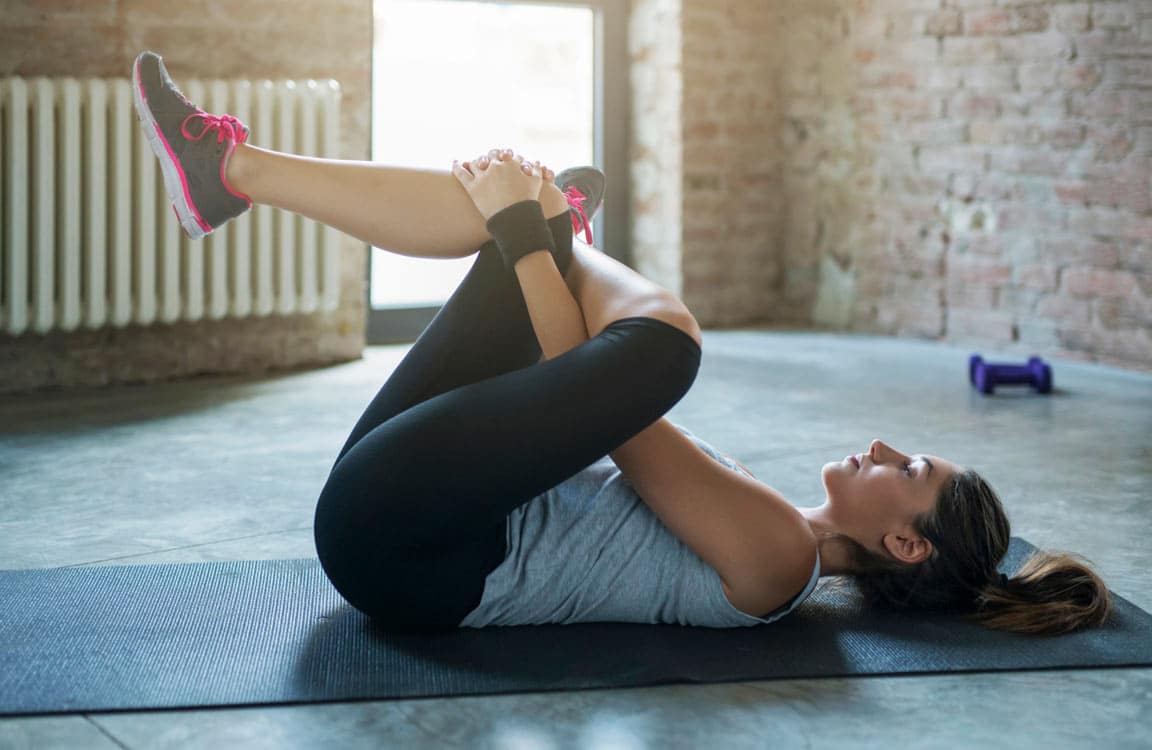
One of the most popular stretches for cyclists is the lying glute stretch (you can also do this stretch while seated on the ground or in a chair).
Starting on your back, bring both of your knees up towards your chest. Then, cross one leg over the other, resting your ankle on the thigh of the opposite leg.
Grab the hamstring of the uncrossed leg, and use your elbows to maintain the position as you pull your lower leg towards your chest.
You should feel a long and deep stretch through the glute, thigh, and hip of your crossed leg.
FAQ
Are foam rollers good for cyclists?
Yes! Foam rollers are good for everyone – they are used to relieve muscle tension, pain, and soreness, and so everyone can benefit whether you’re a professional cyclist or working at a desk all day. There is little evidence that pre-ride foam rolling increases cycling performance, and most science points to better recovery from post-ride foam rolling.
Should you use a foam roller after cycling?
Yes, foam rolling is more beneficial when done after a cycling workout than before. Anyone and everyone can benefit from foam rolling, as the process can help speed up muscle recovery and decrease muscle pain and soreness.
Which foam roller is best?
For beginners, the Gaiam Restore Foam Roller is the best place to start because of its relatively soft material that won’t be too painful.
For experienced foam rollers, the Amazon Basics High-Density foam roller is the best traditional foam roller that you can use on a variety of large muscles and whole muscle groups, while the Trigger Point Performance GRID foam roller is our favorite foam roller overall. The GRID has ridges and a hollow interior which create a firmer feel that is also flexible, all of which can be used to target specific knots and muscles.
Are bumpy or smooth foam rollers better?
Neither type is better overall, but each is better at achieving certain things.
Bumpy foam rollers are best at targeting small and specific muscles and knots and achieving a harder overall massage and myofascial release. Smooth foam rollers are better at massaging whole muscle groups and joints, providing a softer massage that is less painful and more enjoyable.
In general, bumpy foam rollers are better for experienced foam rollers while smooth foam rollers are better for beginners.
Should I foam roll quads?
Yes, the quads are one of the hardest-working muscles during cycling, and so they are often one of the sorest muscles. Foam rolling can help relieve quad soreness and tension, which leads to better recovery and less pain – which is always good!
How often can I use a foam roller?
You can use a foam roller at any time of day, every day. Be careful to not overdo it, as you don’t want to do more harm to your muscles than good. If you foam roll more than once per day, keep your sessions short and the pressure of the target muscle fairly light. If your muscles are sorer the following day, or your recovery has gotten worse, then you are foam rolling too much.
How do you use a foam roller for cycling?
Foam rollers can be used to loosen or lengthen muscles before a ride, and used to relieve muscle soreness and pain after a ride. Pre-ride foam rolling has more to do with flexibility and range of motion, while post-ride foam rolling has to do with recovery and myofascial release.
How long should I foam roll my quads?
As with each foam rolling movement, you should roll up and down each muscle for 30-60 seconds. Less than that, and you won’t do enough to make a difference, but more than that and you could be damaging the muscle.
Keep in mind that the quad is four different muscles, so you can roll the inside, outside, and center of your quad in three different movements, each lasting 30-60 seconds.
Why does it hurt to foam roll quads?
The quads are some of the largest and most powerful muscles in our bodies. They get worked extremely hard during cycling. Exercise causes muscle contraction. When you’re pedaling a bicycle, your quads are contracting at a rate of ~100 times per minute. Multiply that by the number of minutes or hours that you’ve ridden. That’s a lot of work that your quads have done.
Cycling causes tension and soreness in your quads, and foam rolling is meant to relieve that tension. Like breaking up any muscle tissue, the process is not exactly pleasurable and is sometimes purely painful. Keep the pressure light and the sessions relatively short. You don’t want to do even more damage to your muscles. Your muscles should feel better after foam rolling, not worse.
Can you overuse a foam roller?
Yes, foam rollers are damaging to the muscle – although some damage is good. But just like an aspect of exercise, it is possible to overdo it and do more harm than good. So use a foam roller lightly at first, and never for more than 30 minutes at a time. If you are foam rolling too long or too deep, you will notice excess soreness in your muscles for 24-48 hours afterward, and sometimes even bruising.

